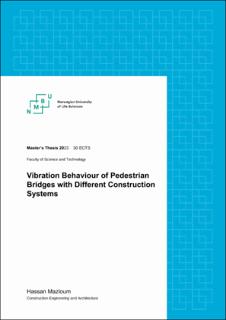| dc.description.abstract | The design of pedestrian bridges is continuously being developed and the mechanical properties influence the dynamic properties in the SLS. Pedestrian induced vibrations have been a major concern regarding design criteria and construction. The opening of the
Millennium bridge in London in 2000 made headlines regarding the matter and several researchers and papers have been assessing vibrations on pedestrian bridges due to pedestrian loading. Thus, the main goal of this thesis is to contribute to the global community researching the matter with the implementation of field tests and numerical solutions with the use of FE-modelling.
The procedure in this thesis involved field tests on two bridges with different systems and materials. The field tests estimated natural frequencies, mode shapes and their respective damping ratios. Results from the field test modal analyses were used to validate a FE-model and the verified model employed to perform a parametric study that showed the development of frequencies and modes as the span changed. Following the modal analyses time-history response analyses computing the Vibration Dose Values (VDV) and Root Mean Square (RMS) were evaluated and compared with the ISO 10137. The accelerations recorded in the field tests were then compared to calculated accelerations in different national and international guidelines. The guideline compared in this thesis includes Statens Vegvesens Handbook N185, the Eurocodes, the UK-NA to Eurocode 1, ISO 10137, SÉTRA, and the JRC.
The modes in both running and walking corresponded both in terms of mode shapes and natural frequencies. The frequency discrepancies were low for both activities resulting in acceptable results. Very good correspondence was also achieved between test and FE results. Furthermore, the calculated running accelerations were more in line with the limits of all guidelines. The walking acceleration did not satisfy all the guideline within the same margins. However, the damping ratios in the respective guidelines, implemented in the guideline calculations were not correspondent with the effective damping ratios from the field results, resulting in high accelerations. | |
